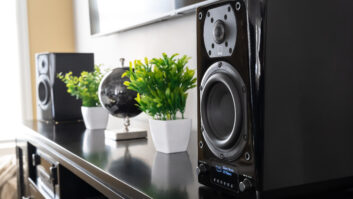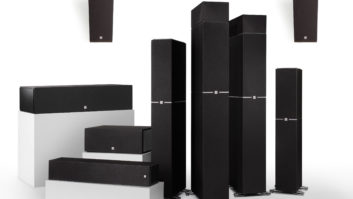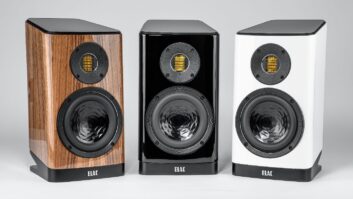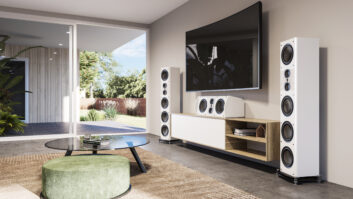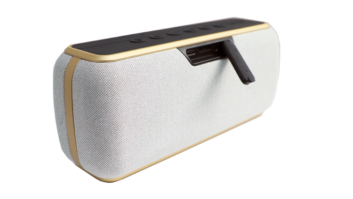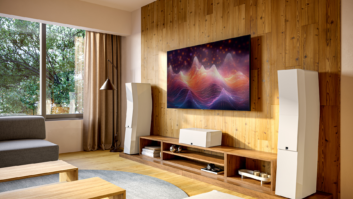At the risk of getting a little too meta, let’s talk for a minute about the thought process that precedes the writing of a product review. I’m not talking about the installing and poking and prodding a product, mind you; that part is relatively easy. I mean the actual keyboard clacking that follows–telling the story. If there’s something distinctive about the gear in question, one runs the risk of overemphasizing it to the detriment of everything else the product does well. Or conversely, deemphasizing that special quality to the point where the thing that makes it tick gets lost in the shuffle.
With a product like Definitive Technology’s BP9060 tower speaker, there are a few such considerations to juggle, some novel and some rather expected. In the latter category is the speaker’s bipolar design, with a rear-firing 4.5-inch mid driver and one-inch tweeter complementing its pair of front-firing 4.5-inch mids and one-inch tweeter, as well as a side-mounted 10-inch powered sub and dual 10-inch passive radiators. In contrast with Definitive Technology speakers of old, though, the company has employed here what it calls “Forward-Focused Bipolar” design, which simply means that the front-firing driver array is louder than the rear-firing speakers, for improved stereo imaging.

Looking down at the Definitive Technology BP9060 Bipolar Tower Speaker
Somewhat less expected is the hidden connector port atop the BP9060, concealed beneath a magnetically affixed aluminum plate that pops off with a simple push and a pull, designed expressly for use with Definitive’s A90 speaker module. Add the A90 and you now have access to an upward-firing height speaker for Dolby Atmos and DTS:X, which is fed by a second pair of speaker binding posts just over the main pair. Of course, add-on speaker modules of this sort aren’t rare in and of themselves. What makes Definitive Technology’s implementation so distinctive is that the resulting speaker/speaker-module combo doesn’t look or feel like a kludge. In fact, I’d go so far as to say that the A90 improves on the aesthetics of the BP9060, if anything, and that’s not even considering that you don’t have speaker cables dangling from the top, thanks to Definitive’s forethought.
Forethought, when you get right down to it, is a common theme with the BP9060, which becomes apparent the moment you open the box. Before, in fact. I can’t tell you how many speakers I’ve unboxed this year (it’s a lot), but by far the vast majority of them have come in boxes that seem designed with no consideration for the person on the other end of the retail chain who has to open them. The packaging for the BP9060, in contrast, almost seems to have been designed alongside the speaker itself. Clear markings direct you to flip it over and open from the bottom. Once you do, you’ll see that the aluminum stand is right there in a separate little box (which also contains carpet spikes, etc.), and it couldn’t be simpler to install said stand before flipping over the box again and extracting the fully assembled speaker.

A close up of the base of Definitive Technology’s BP9060 and its height-channel module
On the other hand, the BP9060’s non-removable sock/grille does make it a little more difficult to move around and position once unboxed, which I only really point out because I spent more time tinkering with positioning than is normally necessary with most speakers of this size. That isn’t, as you might expect, due to the speaker’s bipolar design. In terms of distance from boundaries, I found the BP9060 to be very forgiving. What proved to be trickier was getting the speakers positioned for optimal performance from their powered (and powerful) built-in subwoofers.

The BP9060’s Intelligent Bass Control definitely helped some in that department. It’s a fancy name for what seems to be such a simple knob, but behind the scenes the Intelligent Bass Control really is a sophisticated DSP that tweaks low bass output without doing too much to the upper end of the sub’s range (and hence its crossover point with the BP9060’s mid drivers).
I’d love to tell you the process of arriving at the right combination of position and Intelligent Bass Control levels was more scientific, but it really amounted to quite a bit of scootching and tweaking, and listening and tweaking, and scootching and listening, and tweaking a bit more. But it was all very much worth it. In the end, I may not have been able to achieve Definitive Technology’s reported low-frequency extension of 18Hz, but the speakers did pump out plenty of useable bass down to just south of 30Hz–deeper than a lot of standalone subs I’ve tested. And the Intelligent Bass Control also allowed me to get rid of a very faint bit of passive radiator noise I heard when listening to Björk’s “Hyperballad.”
To sum up in one word the sound of the BP9060s after all that was done, it would be “big.” I started with a few days of purely stereo listening to get a handle on the performance of the speakers in and of themselves, and although some simple tracks like “Sir Patrick Spens” (Child 58) from Anaïs Mitchell and Jefferson Hamer’s Child Ballads album sound perhaps a little too large, that’s merely a subjective observation. The simple fact of the matter is that these speakers shone brightly with 99.9 percent of my music collection in a way quite unlike any other speaker I’ve auditioned in years. Prince & the Revolution’s “When Doves Cry” was a downright revelation, especially in terms size and sense of space.
By far the best time I had with these speakers, though, was exploring my massive collection of Grateful Dead soundboard recordings, especially from the band’s 1974 “Wall of Sound” era. These (relatively) little speakers’ ability to recreate the effect of that ginormous PA system simply floored me, and the built-in subs transported me directly to the Phil Zone–that area of the audience beloved by Deadheads for the tummy-rumbling strength of Phil Lesh’s bass.
I wish I had more space in which to discuss the BP9060’s performance as part of a larger surround sound system, because Definitive also provided me with its CS9080 center channel, along with the two A90 speaker modules. Like the BP9060, the CS9080 includes a built-in sub (eight-inch, along with a 10-inch passive radiator), an LFE input, and a power cord. Unlike the BP9060, it’s not a bipolar speaker. In isolation, that does result in a slightly more focused sound, but as part of a larger surround system it’s not something you notice. The center blends well with the towers, and its handling of dialogue is excellent, largely due to its wonderfully neutral midrange and lack of resonance. I’ll admit I did have to cross the CS9080 over at 80Hz because its sub proved too much for my credenza to handle, but I suspect that’s largely due to the fact that it didn’t have enough room to breathe. Placement atop, rather than within, the credenza would have been ideal, I think, had I room for such.
As for the A90 speaker modules, I found their effect with Atmos titles (like Batman v Superman) subtle yet effective–definitely not as pronounced as dedicated in-ceiling speakers, but not as distracting, either. If anything, I found the experience to be more like that of a large cinema with Atmos than the tighter, more pronounced effect one often experiences at home.
Looping back around to my opening thoughts: in all of the discussion about what makes the BP9060 (and the rest of Definitive Technology’s new line) so distinctive, I feel the need to stress that they also do the things that normal speakers are supposed to do, and they do them very well. They’re neutral. They’re dynamic. They’re revealing and detailed.
But above all else, they’re just plain fun to listen to.
800.228.7148
definitivetechnology.com
Kudos
An incredible-sounding speaker with oodles of distinctive design features. Its built-in (and hidden!) connector port for the company’s A90 speaker module for Atmos and DTS:X is genius, and its “Forward-Focused Bipolar” design strike a wonderful compromise between the huge sound of traditional bipolar speakers and the imaging and focus of direct speakers.
Concerns
Proper setup can take some time, as its built-in subwoofer necessitates careful placement and a bit of tweaking.
Product Specs
► Dimensions with base (hwd): 44.5″ x 11″ x 13″ (113.03cm x 27.94cm x 33.02cm)
► Front Array Driver Complement
► 1″ (2.54 cm) Aluminum Dome Tweeter
► 2 x 4.5″ (11.43cm) Midrange Drivers
► 2 x 10″ (25.4cm) Bass Radiators
► 10″ (25.4cm) Subwoofer
► Rear Array Driver Complement
► 1″ (2.54cm) Aluminum Dome Tweeter
► 4.5″ (11.43cm) Midrange Driver
► Total Frequency Response: 18Hz–40kHz
► M ax Sensitivity (1 watt at 1 meter): 92dB

